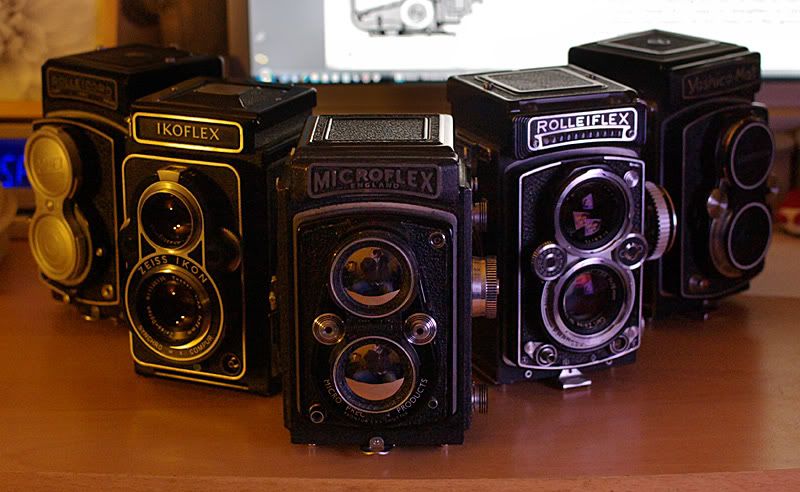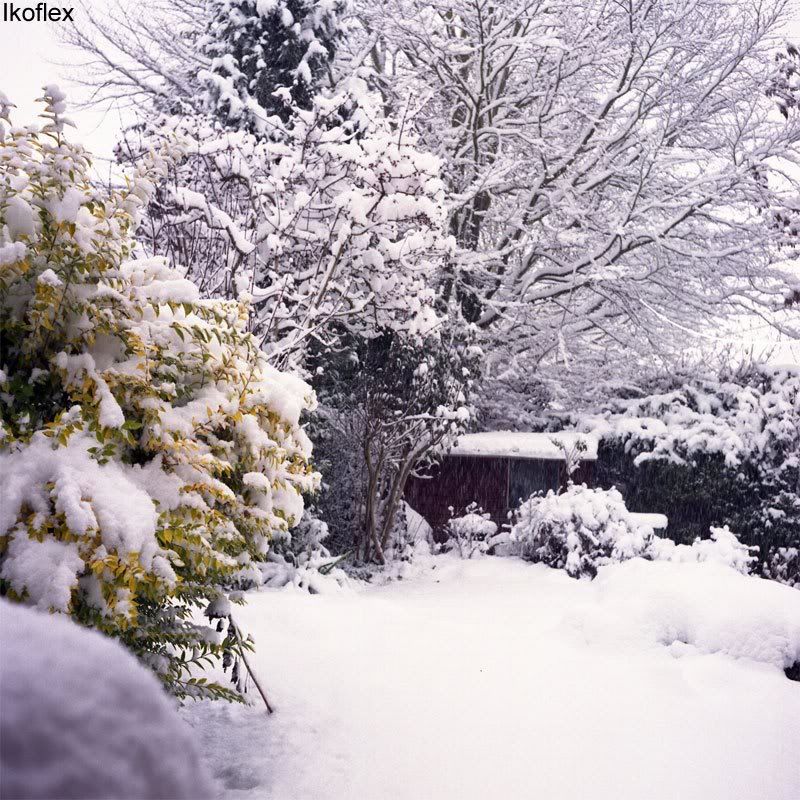hefty
Established
I have more TLR cameras than I really want at the moment (don't worry, I'm not expecting sympathy for that statement) and after Christmas at least two (maybe three) must go in order to replenish my camera gear slush fund.
The contenders are (left to right) a Rolleicord III, an Ikoflex IIa, a Microflex, a Rolleiflex 3.5E and a Yashica-Mat.

The Rolleicord I've had for around 20 years (my first medium format camera), although it spent about ten of them in a cupboard when I discovered digital cameras. It came back into use around 2 years ago and it was serviced by Rollei at the factory before being laid up - it works like new. The Yashica-Mat I bought by pure chance around a year ago and immediately loved; it hasn't been serviced but then it's never appeared to need it (although I did replace the light seals on the film door when I first got it). The Microflex came recently from eBay as a spares/repairs camera (very cheap) and it's been completely overhauled (not cheap) - all seems well, but it's untested with film as I haven't had much time in the last few weeks.
Last Sunday I went to a camera fair to hunt down a Microflex lens cap (and found one!) but ended up coming home with the Rolleiflex, because I wanted to see what the fuss is all about, and the Ikoflex; simply because it enchanted me. It's a beautiful camera to behold and I was smitten at first fondle (although it has a couple of unusual quirks that may or may not grow on me in actual use).
Neither of the new cameras has been tested with film and the Ikoflex certainly needs a service as the focus is too stiff. Both have shutters that sound about right to my ear, but I have yet to discover whether there are any film transport problems. I'm not expecting any though, as they both appear to be in pretty good shape overall. If I end up keeping the Ikoflex then I'll get it serviced; with the Rolleiflex I'll follow the "If it ain't broke don't fix it" school of thought that has applied to the Yashica-Mat.
The contest will take place over the holiday period (assuming my film arrives in time) with a shoot-out. I'll be putting a roll of Fuji Reala 100 through each camera, as that's my most used emulsion.
The idea is to take two shots of six scenes with each camera. Just in case the first shot goes horribly wrong at some point - almost inevitable with the Rolleicord taking part, due to it's non-existent interlock combined with my woeful memory.
The first scene will be a shot of the other four cameras each time, it doubles as an identifier as to which camera shot which negatives when they come back from the lab. This will be a tripod shot, probably at medium-wide aperture (f/5.6-8 or so) and naturally lit.
The other five scenes are still pretty much undecided and I'm open to suggestions. I want a broad spread so the lenses get used both wide open and closed down, and at various distances. I won't be wasting any on charts and brick walls as this is predominantly a test of which lens takes the prettiest picture. There should probably be a landscape and a portrait in there somewhere I guess.
I've already decided the Rolleiflex, although not perfect, is the best when it comes to ergonomics. Having said that, every camera here has something about it that I uniquely like - even the Rolleicord. It has the focus knob on the right where it feels so much more natural to me - all the others make me focus with the left hand. It's a small point but it all gets taken into account.
I'm expecting to like the results from the Rolleiflex and the Microflex the best, although I'm prepared to be surprised. The Xenar on the Rolleicord and the Yashinon on the Yashica are lenses that I'm familiar with (albeit not tested back-to-back before) and know to be superb, so the bar is already set high. Also, I'm basing my guesswork largely on the evidence of other peoples' photos that I've looked at on the net (several on this forum), so it's not exactly a foolproof plan. The Ikoflex's Tessar is sort-of familiar to me as I used a Super Ikonta of similar vintage for a while. If this Tessar is as good as the one on the Super Ikonta then I rule no winner out.
I'll be keeping the two winners of the contest (maybe three if it's a close run thing). I'll be quite sad to see any of them go but I don't like owning cameras that I know I won't use - I can see me taking two to an event (especially if it's an indoor / outdoor one and different films are required concurrently) but three's pushing it and more than that is really out of the question unfortunately. Mind you, I said at the start of last year I was giving up 35mm for good and sticking purely to digital and 120 film from now on; well I ended up shooting a couple of rolls of 35mm this year anyway (and kept a couple of cameras for sentimental reasons) so I reserve the right to modify or even cancel this year's resolution.
That's my photographic goal for this winter anyway. I'm quite a fairweather shooter with film so it'll be nice to get this sorted out now, before Spring rolls around and I stagger out of the house blinking at a barely-remembered Sun and looking for things to photograph.
So would anybody like to see the results in about a month or so?
The contenders are (left to right) a Rolleicord III, an Ikoflex IIa, a Microflex, a Rolleiflex 3.5E and a Yashica-Mat.

The Rolleicord I've had for around 20 years (my first medium format camera), although it spent about ten of them in a cupboard when I discovered digital cameras. It came back into use around 2 years ago and it was serviced by Rollei at the factory before being laid up - it works like new. The Yashica-Mat I bought by pure chance around a year ago and immediately loved; it hasn't been serviced but then it's never appeared to need it (although I did replace the light seals on the film door when I first got it). The Microflex came recently from eBay as a spares/repairs camera (very cheap) and it's been completely overhauled (not cheap) - all seems well, but it's untested with film as I haven't had much time in the last few weeks.
Last Sunday I went to a camera fair to hunt down a Microflex lens cap (and found one!) but ended up coming home with the Rolleiflex, because I wanted to see what the fuss is all about, and the Ikoflex; simply because it enchanted me. It's a beautiful camera to behold and I was smitten at first fondle (although it has a couple of unusual quirks that may or may not grow on me in actual use).
Neither of the new cameras has been tested with film and the Ikoflex certainly needs a service as the focus is too stiff. Both have shutters that sound about right to my ear, but I have yet to discover whether there are any film transport problems. I'm not expecting any though, as they both appear to be in pretty good shape overall. If I end up keeping the Ikoflex then I'll get it serviced; with the Rolleiflex I'll follow the "If it ain't broke don't fix it" school of thought that has applied to the Yashica-Mat.
The contest will take place over the holiday period (assuming my film arrives in time) with a shoot-out. I'll be putting a roll of Fuji Reala 100 through each camera, as that's my most used emulsion.
The idea is to take two shots of six scenes with each camera. Just in case the first shot goes horribly wrong at some point - almost inevitable with the Rolleicord taking part, due to it's non-existent interlock combined with my woeful memory.
The first scene will be a shot of the other four cameras each time, it doubles as an identifier as to which camera shot which negatives when they come back from the lab. This will be a tripod shot, probably at medium-wide aperture (f/5.6-8 or so) and naturally lit.
The other five scenes are still pretty much undecided and I'm open to suggestions. I want a broad spread so the lenses get used both wide open and closed down, and at various distances. I won't be wasting any on charts and brick walls as this is predominantly a test of which lens takes the prettiest picture. There should probably be a landscape and a portrait in there somewhere I guess.
I've already decided the Rolleiflex, although not perfect, is the best when it comes to ergonomics. Having said that, every camera here has something about it that I uniquely like - even the Rolleicord. It has the focus knob on the right where it feels so much more natural to me - all the others make me focus with the left hand. It's a small point but it all gets taken into account.
I'm expecting to like the results from the Rolleiflex and the Microflex the best, although I'm prepared to be surprised. The Xenar on the Rolleicord and the Yashinon on the Yashica are lenses that I'm familiar with (albeit not tested back-to-back before) and know to be superb, so the bar is already set high. Also, I'm basing my guesswork largely on the evidence of other peoples' photos that I've looked at on the net (several on this forum), so it's not exactly a foolproof plan. The Ikoflex's Tessar is sort-of familiar to me as I used a Super Ikonta of similar vintage for a while. If this Tessar is as good as the one on the Super Ikonta then I rule no winner out.
I'll be keeping the two winners of the contest (maybe three if it's a close run thing). I'll be quite sad to see any of them go but I don't like owning cameras that I know I won't use - I can see me taking two to an event (especially if it's an indoor / outdoor one and different films are required concurrently) but three's pushing it and more than that is really out of the question unfortunately. Mind you, I said at the start of last year I was giving up 35mm for good and sticking purely to digital and 120 film from now on; well I ended up shooting a couple of rolls of 35mm this year anyway (and kept a couple of cameras for sentimental reasons) so I reserve the right to modify or even cancel this year's resolution.
That's my photographic goal for this winter anyway. I'm quite a fairweather shooter with film so it'll be nice to get this sorted out now, before Spring rolls around and I stagger out of the house blinking at a barely-remembered Sun and looking for things to photograph.
So would anybody like to see the results in about a month or so?
Last edited:









